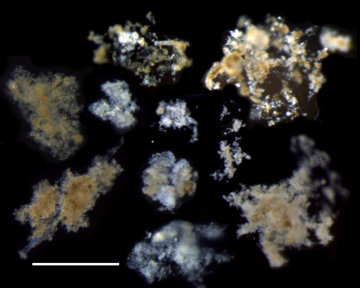720224_Deep Snow_360 px width.png

Marine snow is made up of tiny particles of bacteria, fish poop and more that drift to the sea floor like snowflakes. Scale bar represents 1 millimeter. Image courtesy of Dr. Colleen Durkin, MBARI
It snows in the oceans. Bacteria, the skin cells of fish, fish poop, and bits of sand and dirt all clump together. These “snowflakes” can be up to an inch or two across. Many of them are eaten as they sink toward the ocean floor. But others float all the way to the bottom—a trip that can take weeks.
The snow falls all the way down even in the deepest waters, where the pressure can be a thousand times the surface pressure or greater. In fact, a recent study suggests the pressure might actually help the snowflakes survive in the deep ocean.
Scientists in Denmark made their own version of marine snow. They then put some in several different tanks. They rotated the tanks so that the snow was always “falling.” And they increased the pressure in the tanks every day. They then opened some of the tanks when the snow had reached different “depths” to see how much had remained intact.
Down to the equivalent of about four miles, the snowflakes gradually fell apart, and the living bacteria basically shut down. Below that depth, however, the process stopped—the flakes held together. By the time they hit about six miles—deeper than more than 99 percent of the world’s oceans—about half of the original flakes had survived.
Marine snow is the main food source for much of the life on the floor of the deep oceans. It also socks away carbon from the atmosphere, helping reduce global warming. So about all we can add is this: Let it snow, let it snow, let it snow!

